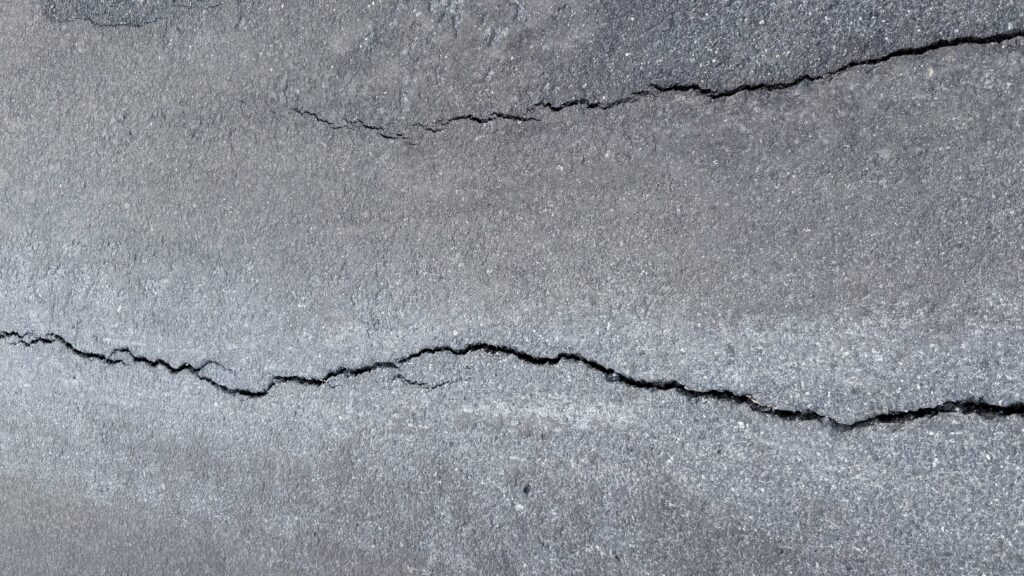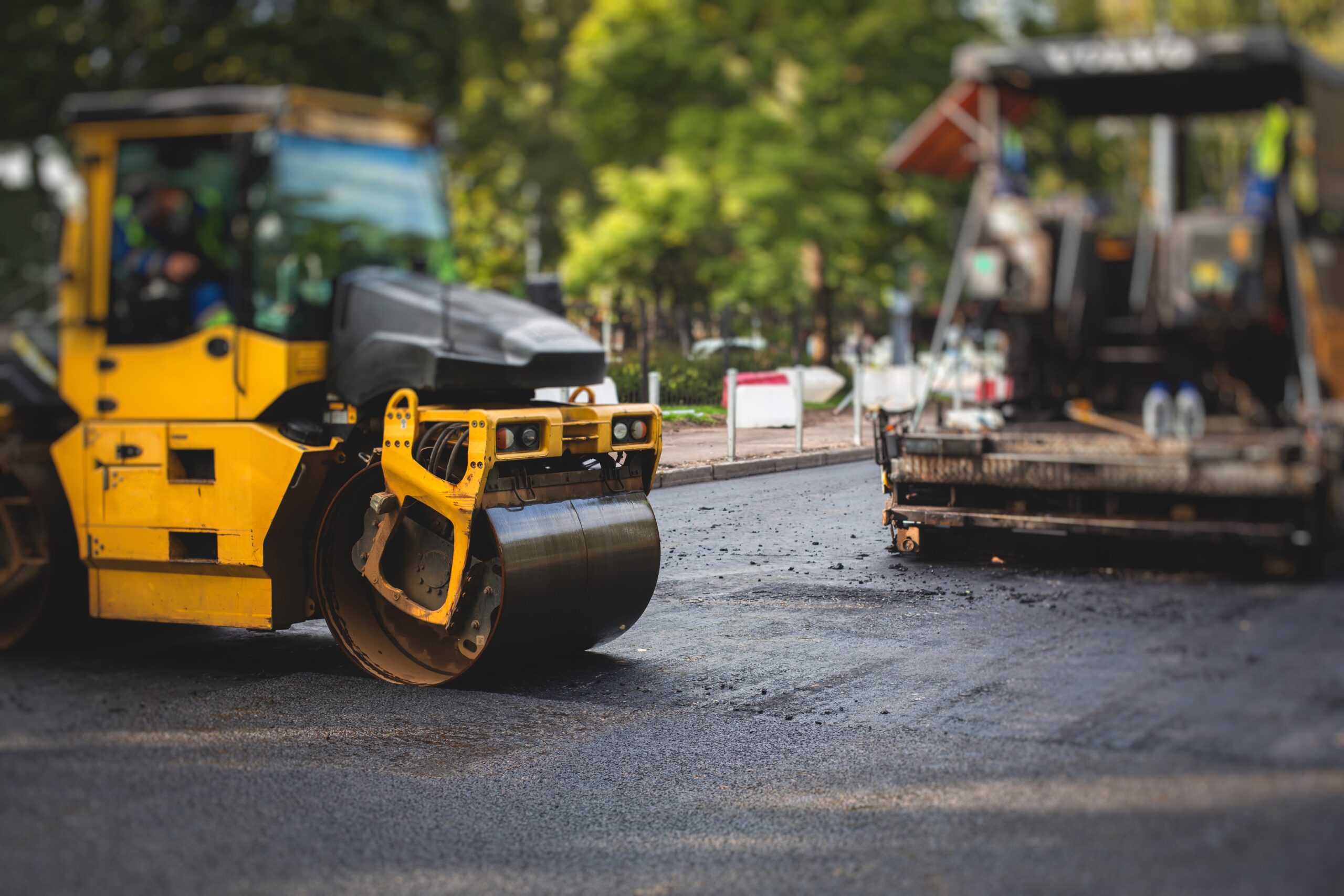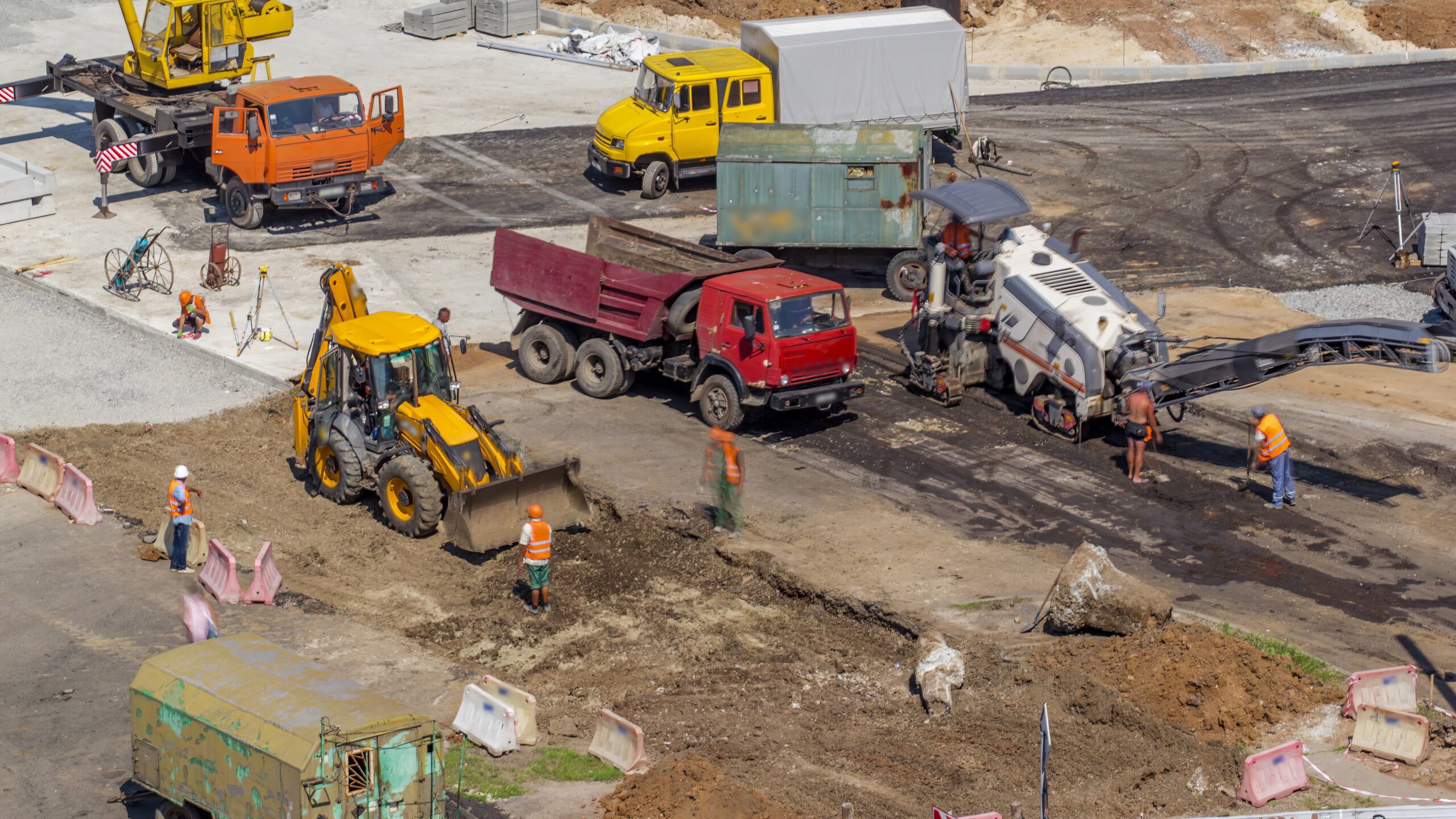
Denver’s weather is unpredictable. A sunny morning can turn into a freezing evening, and snowmelt one day may refreeze by the next. These constant temperature swings put serious stress on paved surfaces. Asphalt expands and contracts, moisture seeps in, and small cracks can quickly grow if left untreated.
For property owners, choosing the right repair method can mean the difference between extending a parking lot’s life or facing costly repairs. Crack sealing and patching both have important roles but serve different purposes. Crack sealing is preventive, helping keep pavement healthy and in good condition. Patching is a corrective measure, repairing areas where damage has already progressed.
In Denver, with its freeze-thaw cycles, high UV exposure, and altitude-related stresses, the best approach depends on current pavement conditions and how they will respond to future weather. This guide explains how crack sealing and patching work, the challenges posed by Denver’s climate, and how to make the most effective repair decisions.
When Small Cracks First Appear: The Case for Crack Sealing
Every paved surface will crack eventually. It’s the natural result of oxidation, movement, and time. But the earlier those cracks are sealed, the better. Crack sealing is the art of protection, blocking water and debris from infiltrating beneath the surface, where they can freeze, expand, and tear the pavement apart.
Investing in preventive crack sealing is highly cost-effective. Research shows that for every $1 spent on pavement preservation, about $6 to $10 can be saved on major repair costs in the future. This illustrates how early action can protect your pavement and reduce long-term expenses.
Let’s discover how it saves the pavements and fills the cracks.
What Crack Sealing Actually Does
Crack sealing involves cleaning, heating, and filling active cracks with a rubberized asphalt sealant. This flexible material bonds to the walls of the crack and moves with the pavement as it expands and contracts. According to the Federal Highway Administration (FHWA), properly sealed cracks can significantly delay structural deterioration and prevent costly reconstruction down the road. The method acts like a waterproof membrane, protecting from freeze-thaw damage and halting crack propagation.
Ideal Conditions for Sealing in Denver
Timing is crucial for sealing success. In Denver, ideal conditions occur when temperatures are moderate, typically in late spring or early fall. The surface must be clean and dry, with cracks narrow enough (under ¼ inch) for the sealant to adhere properly. If applied during extreme cold, the material can harden prematurely; in excessive heat, it may not bond evenly. Professional crews familiar with local weather patterns understand how weather impacts asphalt quality and how to find this balance.
Materials That Endure the Altitude
Not all sealants perform the same in Denver’s conditions. High-altitude UV exposure and freeze-thaw cycles demand polymer-modified or rubberized sealants designed to remain flexible in temperature swings. This elasticity ensures the sealant moves with the pavement, rather than cracking under stress.
Longevity and Maintenance
When done correctly, crack sealing can extend pavement life by up to five years or more. It’s cost-effective and repeatable, making it a cornerstone of any preventive maintenance plan. However, once cracks deepen or interconnect, sealing is no longer enough, but the underlying base begins to weaken, calling for patching instead.
Can patching fail in Denver’s winters?
Yes, if performed under improper temperatures or without correct compaction. Professional timing and material handling prevent premature failure.
When More Than Sealing Is Needed: Patching Deep Damage
Crack sealing works best as a first defense. But when water, traffic, and time have already caused deeper failures, like potholes or alligator cracking, asphalt patching becomes the only viable solution. Patching restores structure where damage has penetrated below the surface, reinforcing the base and preventing collapse. This is why you should know the difference between crack sealing vs patching.
Identifying When Patching Is Necessary
If cracks exceed a quarter inch, or if you notice crumbling, potholes, or depressions, sealing alone won’t help. These signs point to moisture infiltration or base-layer deterioration. Patching is a corrective process that rebuilds those weakened areas, ensuring the surface regains its strength and uniformity. According to the Colorado Department of Transportation (CDOT), neglecting such damage leads to progressive failures that multiply rapidly during freeze-thaw months.
Types of Patching for Denver Pavements
Two main methods dominate Denver’s asphalt patching landscape: surface patching and full-depth patching. Surface patching replaces only the top layer of asphalt, while full-depth patching removes and reconstructs both the surface and the base. For long-term results in areas with recurring cracks or drainage issues, full-depth patching offers the stability needed to endure Denver’s dramatic weather shifts.
Climate Challenges During Patching
Denver’s combination of altitude, moisture, and sun intensity tests even the best repairs. Improperly compacted patches or unsealed edges can fail quickly when exposed to snowmelt or UV rays. Proper drainage design, along with the use of weather-resistant materials, prevents water from collecting at the joints, a critical step for long-term durability. The U.S. Environmental Protection Agency (EPA) highlights proper drainage as one of the most effective ways to extend pavement lifespan and reduce environmental impact.
Cost and Durability Considerations
While patching costs more than sealing, it restores integrity to areas where sealing can’t. Well-executed patches can last several years and help prevent full resurfacing projects. The trade-off is time and disruption: patches require more labor, equipment, and curing time. But when performed by seasoned professionals, patching delivers long-term peace of mind.
What’s the difference between surface and full-depth patching?
Surface patching replaces the top layer only, while full-depth patching rebuilds both the surface and base layers for structural reinforcement.
How Denver’s Climate Shapes the Choice
Denver’s climate isn’t just unpredictable, it’s punishing for asphalt. The altitude amplifies UV exposure, freeze-thaw cycles wreak havoc on cracks, and sudden storms often saturate pavement before temperatures plummet. The result? A demanding environment that pushes every repair technique to its limits.
Have a look at how the extreme weather of Denver is causing damage to the asphalt layers.
The Freeze-Thaw Cycle’s Hidden Damage
Every time water seeps into cracks and freezes, it expands, forcing pavement apart. When it thaws, those cracks remain slightly wider, letting in more water next time. This cycle repeats all winter long. Crack sealing, applied early, interrupts that destructive rhythm by sealing out moisture before it can reach the base.
The Impact of UV and Solar Gain
Denver’s elevation, over 5,000 feet, means increased exposure to ultraviolet radiation. Prolonged sunlight dries out asphalt binders, causing them to stiffen and fracture. Sealants with UV stabilizers and flexible polymers resist this damage better than untreated surfaces. Patching, too, must use fresh, UV-resistant materials to prevent premature brittleness.
Drainage and Grading Requirements
Proper drainage design is vital. Poor grading allows water to accumulate, accelerating the freeze-thaw process. According to the U.S. Department of Transportation (DOT), maintaining drainage flow prevents water pooling that leads to subgrade weakening and cracking. Denver’s rolling terrain and snowmelt runoff make attention to slope and grading critical.
Maintenance Timing and Seasonal Planning
Because Denver’s repair windows are narrow, spring and early fall are optimal, but timing matters. Sealing too late in the year risks freeze failures, while summer heat can cause materials to expand excessively. Scheduling work with experienced contractors ensures repairs occur under stable, predictable weather conditions. It is important to know when asphalt milling is better than full replacement.
How does UV exposure affect asphalt in Denver?
The city’s thinner atmosphere allows stronger UV rays to reach the surface, drying out asphalt binders. This makes the pavement brittle and more prone to cracking unless it’s treated with UV-resistant sealants.
A Balanced Approach: Combining Sealing and Patching
In reality, most properties benefit from a combined strategy. Crack sealing and patching are not rivals, but they’re complementary tools that, when used together, protect pavement from early decay and major failure. The right plan depends on regular inspections, damage mapping, and phased maintenance.
Here, we will determine the best plan to achieve the desired results.
Inspection and Prioritization
Routine inspections identify early warning signs before they escalate. Hairline cracks should be sealed promptly, while deeper or clustered damage should be marked for patching. A blend of small-scale sealing and targeted patching ensures every square foot receives the attention it deserves.
Adapting to Traffic and Use
Not all pavement wears evenly. Heavy-traffic zones like entrances and loading areas often need more durable repairs, while lighter-use edges may last longer with sealant. Adjusting techniques by usage patterns increases cost efficiency and extends pavement life.
Selecting Materials That Match Denver’s Demands
Material selection matters as much as timing. Sealants must handle Denver’s high-altitude UV exposure, while patch mixes should maintain flexibility during cold nights. Following recommendations from the National Institute of Building Sciences (NIBS), particularly its Building Enclosure Commissioning Guidelines, helps ensure that both repair types meet environmental performance standards suited to local climates.
Long-Term Maintenance Culture
Crack sealing and patching only work when maintenance continues. Regular cleaning, drainage management, and re-sealing when necessary create a culture of care that prevents small problems from becoming major expenses. Consistent upkeep transforms pavement from a reactive liability into a lasting asset.
Protecting Denver Pavements with Precision: Why Asphalt Coatings Company Leads the Way

Choosing between crack sealing and patching is more than a repair decision, and it’s a strategy for longevity. Denver’s fluctuating weather demands a pavement partner who understands the science of asphalt and the rhythm of local seasons. That’s where Asphalt Coatings Company stands apart.
With decades of experience across Colorado’s toughest terrains, Asphalt Coatings Company specializes in climate-responsive pavement care. Our team combines advanced materials, precise techniques, and deep regional expertise to deliver repairs that last. From sealing fine cracks before winter hits to reconstructing weather-beaten sections with resilient patch mixes, every project is handled with precision and pride.
In a city where every freeze-thaw cycle tests the strength of your pavement, trust Asphalt Coatings Company to keep it strong, smooth, and ready for whatever Denver’s skies bring next. Take the first step now and visit us today for better assistance. Even if you need any other guidance, our expert team is just a call away.
Frequently Asked Questions
What is the best crack sealing method?
Two of the most commonly used methods are flush fill and overband. Flush filling involves applying the sealant so that it’s flush with the pavement. With the overband technique, the sealant fills the crack and forms a wider band over the top of the crack.
Does crack sealing prevent moisture?
The benefits of crack sealing include decreasing further crack deterioration, protecting the pavement structure from moisture damage, and ultimately extending the pavement’s life.
How does crack sealing compare to patching?
Here’s a quick guide: Crack Sealing: Use crack sealing for hairline cracks, minor cracks, and as a preventative measure to stop small cracks from growing. Patching: Use patching for larger cracks (wider than ¼ inch), potholes, and areas where the asphalt surface is broken or missing.
What weather is best for crack sealing?
Some agency specifications, like the Montana Department of Transportation, allow crack sealing in roadway temperatures as low as 35°F (1.7°C). Ideally, the spring or fall is when crack sealing is most effective.
Is crack seal waterproof?
The crack seal creates a water-resistant barrier, effectively preventing water ingress through cracks. Its waterproofing capabilities protect surfaces from moisture damage and contribute to the longevity of interior and exterior structures.
Does crack sealing improve pavement lifespan?
Crack sealing can help extend the life of a roadway, reduce pavement failures, and minimize water infiltration, deterioration, and potholes. This form of preventive maintenance can save money by delaying major reconstructive pavement work.
What is the difference between crack sealer and crack filler?
Crack filling provides a temporary solution and may need reapplication within a year or two. Crack sealing, by contrast, can last many years due to its high-quality materials and water-resistant properties. Crack sealing outperforms filling, making it the more economical choice in the long run.



